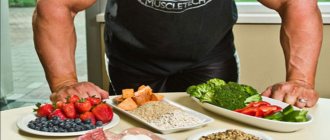What is dry mass gain?
What is lean mass gain? This is a special training and diet regimen that increases the volume of muscle tissue without the formation of fat. By the way, in most cases, the first stage of the “work” of an athlete working on muscle volume is to increase total weight. Naturally, this result is achieved not only due to the development of muscle tissue, but also due to the appearance of fat caused by excess calories in the body. Only after this the athlete begins to work on burning these same fats in order to get beautiful and sculpted muscles (yes, like Schwarzenegger’s).
The essence of gaining lean mass is to increase weight only through muscle growth, but without the formation of excess fat tissue.
Secrets of high-quality muscle building
There are some interesting yet simple secrets that you must know if you want to build lean muscles. Girls can also adhere to these rules.
When compiling your daily diet for the period of muscle gain, proteins should be included in an amount of about 20% of the total daily intake of proteins, fats and carbohydrates. Proteins are found, for example, in fish and poultry, but such products should not be fried, since this method of processing will increase the saturated fat content. The best source of high-quality protein and excellent material for building muscles are boiled eggs, chicken and lean beef.
Carbohydrates are included in the daily diet as much as possible in order to gain muscle mass - their consumption should be at least 70%. Harmful sugars found in baked goods and chocolate must be replaced with complex carbohydrates, and these, in turn, are found in vegetables, fruits, cereals, dairy and whole grain products. As for fruits and vegetables, you need to eat several servings of them daily.
Well, the rest of your diet should be fats - about 10%. We are talking about healthy fats that can be found in olive oil, nuts, avocado and hard cheese.
It is also very important to drink at least five liters of clean water every day.
What you need to know about nutrition to gain lean mass?
According to experienced athletes, the secret to gaining lean muscle mass without fat is in the athlete’s proper and balanced diet. Its main principle should be to limit as much as possible any fatty foods (you will have to give up grandma's cutlets), as well as consume large amounts of carbohydrates with a low and medium glycemic index. Thus, a calorie deficit is ensured, due to which the body begins to burn stored fats in order to ensure the normal functioning of all vital systems.
How many times a day should you eat? It is desirable that the number of meals be at least five times, and the volume of one serving should be no less than three meals a day. The list of permitted foods includes rice, rolled oats, buckwheat, oatmeal, lean meats and fish, vegetables, and seafood. It is advisable to completely avoid bread and various types of sweet pastries. Yes, they contain carbohydrates, but they belong to the “fast” category and can interfere with the athlete’s process of achieving results.
An approximate menu for those who decide to gain lean mass and not gain fat is as follows:
Breakfast:
- oatmeal in water without salt and sugar – 100 g;
- low-fat milk - 1 glass;
- boiled eggs – 3 pcs. (one whole and 2 proteins);
- whole grain bread – 1 piece.
Lunch:
- ripe banana – 1 pc.;
- cottage cheese - 100 grams (fat content up to 5%);
Dinner:
- durum wheat pasta – 100 gr.;
- steamed chicken breast – 100 g;
- vegetable dish – 100 gr.;
- whole grain bread – 1 piece.
Afternoon snack:
- boiled hake fillet (pollock, cod) – 100 g;
- vegetable salad (seasonal) – 100 gr.
Dinner:
- rice or buckwheat porridge - 50 g;
- baked (without oil and spices) chicken/turkey meat - 100 gr.;
- vegetables.
However, it is not enough just to create a nutrition menu; it is important to remember that during the period of weight gain using the “dry” method (usually it is 7-8 weeks), the following rules should be followed:
- 1 week: up to 6 meals (meat, fish, moderately sweet fruits, vegetables, fresh herbs, flaxseed oil are allowed);
- Week 2: the number of meals remains the same, grain porridges are allowed to be consumed until 12-13 noon;
- Week 3: frequent, small meals, no special restrictions on permitted products;
- Week 4: up to 100 grams of porridge (any) is allowed, carrots, beets, and potatoes are prohibited;
- Week 5: grain porridges are removed from the diet, and dairy products and eggs (cottage cheese, low-fat yoghurts and milk) take their place;
- Week 6: any dairy products are completely excluded from the athlete’s menu;
- Week 7: vegetables, fish, seafood, fresh herbs.
If after week 7 you continue to adhere to a strict diet, then the menu for weeks 8-12 should correspond to weeks 4-1 with the gradual introduction of milk, fruits, and vegetables.
How to gain lean muscle mass
We all agree that in order to gain weight we must eat, right?
I think so too, otherwise you have come to the wrong site.
5 Tips for Lean Bulk (Carbohydrate Rotation)
5 basic tips to stay in good shape even during the bulking period
If you train without taking any drugs, you will not be able to gain weight or significantly build muscle without a calorie surplus, in other words, hypertrophy is only possible by consuming more energy than you expend.
Conversely, if you don't eat enough, your muscle size will likely decrease no matter how hard you train.
Sports nutrition for gaining lean mass
Should I use sports supplements to gain muscle mass without fat? Sports nutrition for gaining lean muscle mass is an indispensable element of an athlete’s diet. At the same time, you need to take not just one type of sports nutrition, but several different types:
- Whey Protein: This product is a concentrated protein mixture derived from whey. Proteins are widely used by athletes and bodybuilders, as they allow for effective growth of muscle tissue and guarantee rapid fat burning;
- casein: a special type of protein obtained from dairy products, entering the athlete’s stomach, it provides long-term saturation of the body with amino acids, and also relieves hunger;
- Creatine monohydrate: This is one of the most common forms of creatine and is an indispensable form of sports nutrition for people who want to gain muscle mass. In addition, its use helps to increase strength and endurance;
- BCAA: These essential amino acids not only take part in the formation of protein, but are also an important source of energy;
- vitamin and mineral complexes: the use of vitamins is a mandatory requirement for professionals and amateur athletes, because they improve metabolism and also contribute to the proper functioning of hormones and enzymes.
Tips for gaining lean muscle
Double your portions A person gaining lean mass should eat a lot. For example, you can safely increase portions of foods containing protein by 2 or even 3 times.
Eating food on time It is important not only to eat more, but also to do it on time. The optimal number of meals is 5-6 times a day, without leaving more than 3 hours between them.
Do not neglect nutrition after training As a result of training, a person consumes proteins, carbohydrates and fats. Therefore, it is definitely worth eating after a workout - this will allow you to quickly recover from a workout and also lead to muscle growth. If you have done a lot of strength training, a portion of protein will allow you to both restore strength and build muscle tissue.
Consume high-calorie foods Diet for gaining lean mass must include high-calorie foods, because one of the basics of pumping up muscles is consuming more calories than the body burns. The best sources of calories are porridge (buckwheat, oatmeal, brown rice), meat and fish. Be sure to include cottage cheese and hard cheese in your diet.
1g of carbohydrates and proteins contains 4 kcal, and 1g of fat contains approximately 10 kcal. However, this is not a reason to get carried away with the latter: in percentage terms, the correct diet looks something like this - 50% complex (slow) carbohydrates, 40% proteins and 10% fats. Track your calorie intake
How to gain lean mass without fat? Accurately counting the calories you consume is guaranteed to protect you from gaining excess fat. But first you need to determine your basal metabolism (calorie intake to maintain weight), which is individual for each person. Using a calculator, you can calculate your norm using the formula in the table.
Men 66 + (13.7 x body weight) + (5 x height in cm) – (6.8 x age)
Women 655 + (9.6 x body weight) + (1.8 x height in cm) – (4.7 x age)
Then the result must be multiplied by a coefficient characteristic of your level of physical activity:
1.2 – mostly sedentary lifestyle;
1.375 - average activity, corresponds to 2-3 light physical activities per week.
1.55 – high activity, with 3-5 intense sessions per week.
1.725 - very high activity, heavy training 6 to 7 times a week.
As a result, you will get the number of calories needed to maintain your weight. To gain weight, this number must be gradually increased.
Add some cardio training
Gaining weight without cardio training can lead to problems with the cardiovascular system. Why? When you build muscle mass, the volume of blood in your body increases, and since your heart has to pump it, it experiences increased stress. In order for the heart to cope with increased load, it must train and, accordingly, increase in volume.
An additional advantage of cardio is that it helps burn excess fat and speeds up metabolism. They also won't take much time - just 10-15 minutes on the treadmill at the beginning and end of the workout will be enough.
Never exercise on an empty stomach
Without sufficient energy reserves, training will be short and ineffective. The only source of energy is food, so before going to the gym, a small snack is a must. In addition, when exercising on an empty stomach, metabolism can decrease and even muscle mass can be lost.
How should you train?
The choice of training program for gaining lean muscle mass depends on the individual characteristics of each athlete. It matters a lot how you trained before and how accustomed your body is to intense weight gain. We offer an approximate list of workouts for building lean muscle tissue.
For the upper body:
- lifting the barbell in a lying position;
- lifting the block in a sitting position;
- lifting dumbbells;
- biceps curl;
- push-ups on parallel bars.
For the lower body:
- lifting weights with your legs on a machine;
- squats;
- deadlift.
It is important to remember that training should not be of the same type, and therefore cardio and a variety of strength training should be introduced, aimed at all muscle groups. This approach will allow the body to burn fat more efficiently. In addition, you can replace exercises in the gym with cycling or running. At the same time, regardless of what type of load you choose, you must not forget about the preliminary warm-up and cool-down.
In addition, while gaining lean muscle mass, you need to remember to rest. If you visit the gym every day, it will not bring much benefit. Therefore, it is best to train three to four times a week, allowing the body to recover.
Primary requirements
Drying meals for men and women should be frequent and divided. The number of meals per day is 5-6. The structure of the diet is of no small importance: you should completely avoid fatty foods (fried foods, sausages, lard), but you can leave complex carbohydrates - the energy released as a result of their breakdown is necessary for full-fledged training as part of active mass gain.
Recommended carbohydrates:
- Buckwheat;
- Rice;
- Oatmeal;
- Hercules.
It is immediately necessary to clarify that sweets and baked goods ("simple" carbohydrates) should be completely abandoned - they are quickly absorbed by the body, provoke an increase in blood sugar levels, after which glucose begins to actively transform into fat.
Obviously, the diet when gaining lean muscle mass is “built” on protein foods. Amino acids are the main structural elements of muscles. The best options for protein sources are eggs, chicken breast, hard cheese, cottage cheese, low-fat milk, fish.
Proteins are divided into two main types:
- Fast;
- Slow.
The first (dairy products, eggs, poultry, fish) are recommended for consumption in the first half of the day and in order to “close” the protein window after training. Slow proteins (hard cheese, low-fat cottage cheese) are best eaten before bed - they contain protein that is absorbed over a long period of time, so it will saturate the body with essential amino acids.
Speaking of protein, gaining lean mass for girls is not complete without this useful supplement. It is better to avoid casein; preference should be given to whey types of protein, in particular isolate.
It is recommended to drink protein shakes in the morning, on an empty stomach, immediately after training and in the evening, before bed. It is necessary to understand that taking protein concentrate cannot replace a full meal, it must complement it.
Let's consider the ratio of BJU in the structure of the diet of an athlete who wants to gain lean muscle mass:
- Complex carbohydrates – at least 50% (porridge);
- Proteins – 30% (fish, meat, eggs, dairy products, hard cheese);
- Fats – 20% (exclusively of vegetable origin).
Speaking about the structure of the diet when gaining lean muscle mass, we should mention the drinking regime. Drinking fluids (purified water, green tea without sugar) is necessary both before, during and after training. Dehydration is unacceptable, since water takes an active part in all metabolic processes, and its deficiency will disrupt the absorption of nutrients.
How much fluid does an athlete need when cutting? The figure, of course, is individual and is determined by age, gender, body weight, training activity and other factors. The minimum figure, according to experts, is 2 liters per day.
Give up TV series in favor of sleep
If you're trying to build muscle while watching TV shows until 2 a.m., you're simply missing out on giving your muscles time to recover and grow. Seriously, sleep is just as important as exercise and nutrition. Try to maximize sleep time in your schedule.
Spending several thousand rubles a month on various nutritional supplements for weight gain and not getting enough sleep, you are simply flushing your money down the toilet (you might as well just send it to us!).
5 / 5 ( 1 voice )











